Jiale Zhao
Decoding the Ear: A Framework for Objectifying Expressiveness from Human Preference Through Efficient Alignment
Oct 23, 2025Abstract:Recent speech-to-speech (S2S) models generate intelligible speech but still lack natural expressiveness, largely due to the absence of a reliable evaluation metric. Existing approaches, such as subjective MOS ratings, low-level acoustic features, and emotion recognition are costly, limited, or incomplete. To address this, we present DeEAR (Decoding the Expressive Preference of eAR), a framework that converts human preference for speech expressiveness into an objective score. Grounded in phonetics and psychology, DeEAR evaluates speech across three dimensions: Emotion, Prosody, and Spontaneity, achieving strong alignment with human perception (Spearman's Rank Correlation Coefficient, SRCC = 0.86) using fewer than 500 annotated samples. Beyond reliable scoring, DeEAR enables fair benchmarking and targeted data curation. It not only distinguishes expressiveness gaps across S2S models but also selects 14K expressive utterances to form ExpressiveSpeech, which improves the expressive score (from 2.0 to 23.4 on a 100-point scale) of S2S models. Demos and codes are available at https://github.com/FreedomIntelligence/ExpressiveSpeech
Breaking the Exploration Bottleneck: Rubric-Scaffolded Reinforcement Learning for General LLM Reasoning
Aug 23, 2025Abstract:Recent advances in Large Language Models (LLMs) have underscored the potential of Reinforcement Learning (RL) to facilitate the emergence of reasoning capabilities. Despite the encouraging results, a fundamental dilemma persists as RL improvement relies on learning from high-quality samples, yet the exploration for such samples remains bounded by the inherent limitations of LLMs. This, in effect, creates an undesirable cycle in which what cannot be explored cannot be learned. In this work, we propose Rubric-Scaffolded Reinforcement Learning (RuscaRL), a novel instructional scaffolding framework designed to break the exploration bottleneck for general LLM reasoning. Specifically, RuscaRL introduces checklist-style rubrics as (1) explicit scaffolding for exploration during rollout generation, where different rubrics are provided as external guidance within task instructions to steer diverse high-quality responses. This guidance is gradually decayed over time, encouraging the model to internalize the underlying reasoning patterns; (2) verifiable rewards for exploitation during model training, where we can obtain robust LLM-as-a-Judge scores using rubrics as references, enabling effective RL on general reasoning tasks. Extensive experiments demonstrate the superiority of the proposed RuscaRL across various benchmarks, effectively expanding reasoning boundaries under the best-of-N evaluation. Notably, RuscaRL significantly boosts Qwen-2.5-7B-Instruct from 23.6 to 50.3 on HealthBench-500, surpassing GPT-4.1. Furthermore, our fine-tuned variant on Qwen3-30B-A3B-Instruct achieves 61.1 on HealthBench-500, outperforming leading LLMs including OpenAI-o3.
One Object, Multiple Lies: A Benchmark for Cross-task Adversarial Attack on Unified Vision-Language Models
Jul 10, 2025Abstract:Unified vision-language models(VLMs) have recently shown remarkable progress, enabling a single model to flexibly address diverse tasks through different instructions within a shared computational architecture. This instruction-based control mechanism creates unique security challenges, as adversarial inputs must remain effective across multiple task instructions that may be unpredictably applied to process the same malicious content. In this paper, we introduce CrossVLAD, a new benchmark dataset carefully curated from MSCOCO with GPT-4-assisted annotations for systematically evaluating cross-task adversarial attacks on unified VLMs. CrossVLAD centers on the object-change objective-consistently manipulating a target object's classification across four downstream tasks-and proposes a novel success rate metric that measures simultaneous misclassification across all tasks, providing a rigorous evaluation of adversarial transferability. To tackle this challenge, we present CRAFT (Cross-task Region-based Attack Framework with Token-alignment), an efficient region-centric attack method. Extensive experiments on Florence-2 and other popular unified VLMs demonstrate that our method outperforms existing approaches in both overall cross-task attack performance and targeted object-change success rates, highlighting its effectiveness in adversarially influencing unified VLMs across diverse tasks.
TRAIL: Transferable Robust Adversarial Images via Latent diffusion
May 22, 2025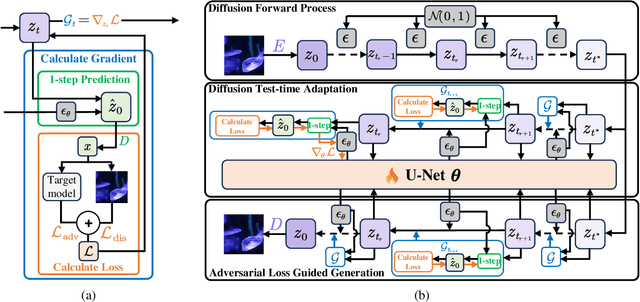
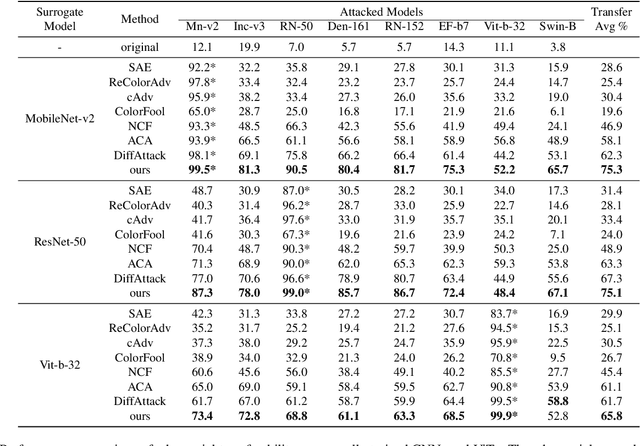

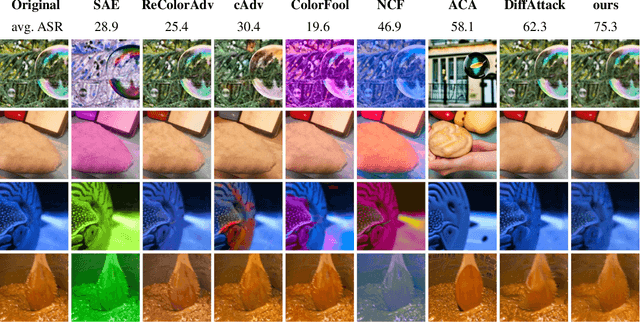
Abstract:Adversarial attacks exploiting unrestricted natural perturbations present severe security risks to deep learning systems, yet their transferability across models remains limited due to distribution mismatches between generated adversarial features and real-world data. While recent works utilize pre-trained diffusion models as adversarial priors, they still encounter challenges due to the distribution shift between the distribution of ideal adversarial samples and the natural image distribution learned by the diffusion model. To address the challenge, we propose Transferable Robust Adversarial Images via Latent Diffusion (TRAIL), a test-time adaptation framework that enables the model to generate images from a distribution of images with adversarial features and closely resembles the target images. To mitigate the distribution shift, during attacks, TRAIL updates the diffusion U-Net's weights by combining adversarial objectives (to mislead victim models) and perceptual constraints (to preserve image realism). The adapted model then generates adversarial samples through iterative noise injection and denoising guided by these objectives. Experiments demonstrate that TRAIL significantly outperforms state-of-the-art methods in cross-model attack transferability, validating that distribution-aligned adversarial feature synthesis is critical for practical black-box attacks.
T2VTextBench: A Human Evaluation Benchmark for Textual Control in Video Generation Models
May 08, 2025Abstract:Thanks to recent advancements in scalable deep architectures and large-scale pretraining, text-to-video generation has achieved unprecedented capabilities in producing high-fidelity, instruction-following content across a wide range of styles, enabling applications in advertising, entertainment, and education. However, these models' ability to render precise on-screen text, such as captions or mathematical formulas, remains largely untested, posing significant challenges for applications requiring exact textual accuracy. In this work, we introduce T2VTextBench, the first human-evaluation benchmark dedicated to evaluating on-screen text fidelity and temporal consistency in text-to-video models. Our suite of prompts integrates complex text strings with dynamic scene changes, testing each model's ability to maintain detailed instructions across frames. We evaluate ten state-of-the-art systems, ranging from open-source solutions to commercial offerings, and find that most struggle to generate legible, consistent text. These results highlight a critical gap in current video generators and provide a clear direction for future research aimed at enhancing textual manipulation in video synthesis.
T2VPhysBench: A First-Principles Benchmark for Physical Consistency in Text-to-Video Generation
May 01, 2025Abstract:Text-to-video generative models have made significant strides in recent years, producing high-quality videos that excel in both aesthetic appeal and accurate instruction following, and have become central to digital art creation and user engagement online. Yet, despite these advancements, their ability to respect fundamental physical laws remains largely untested: many outputs still violate basic constraints such as rigid-body collisions, energy conservation, and gravitational dynamics, resulting in unrealistic or even misleading content. Existing physical-evaluation benchmarks typically rely on automatic, pixel-level metrics applied to simplistic, life-scenario prompts, and thus overlook both human judgment and first-principles physics. To fill this gap, we introduce \textbf{T2VPhysBench}, a first-principled benchmark that systematically evaluates whether state-of-the-art text-to-video systems, both open-source and commercial, obey twelve core physical laws including Newtonian mechanics, conservation principles, and phenomenological effects. Our benchmark employs a rigorous human evaluation protocol and includes three targeted studies: (1) an overall compliance assessment showing that all models score below 0.60 on average in each law category; (2) a prompt-hint ablation revealing that even detailed, law-specific hints fail to remedy physics violations; and (3) a counterfactual robustness test demonstrating that models often generate videos that explicitly break physical rules when so instructed. The results expose persistent limitations in current architectures and offer concrete insights for guiding future research toward truly physics-aware video generation.
Multi-level protein pre-training with Vabs-Net
Feb 05, 2024Abstract:In recent years, there has been a surge in the development of 3D structure-based pre-trained protein models, representing a significant advancement over pre-trained protein language models in various downstream tasks. However, most existing structure-based pre-trained models primarily focus on the residue level, i.e., alpha carbon atoms, while ignoring other atoms like side chain atoms. We argue that modeling proteins at both residue and atom levels is important since the side chain atoms can also be crucial for numerous downstream tasks, for example, molecular docking. Nevertheless, we find that naively combining residue and atom information during pre-training typically fails. We identify a key reason is the information leakage caused by the inclusion of atom structure in the input, which renders residue-level pre-training tasks trivial and results in insufficiently expressive residue representations. To address this issue, we introduce a span mask pre-training strategy on 3D protein chains to learn meaningful representations of both residues and atoms. This leads to a simple yet effective approach to learning protein representation suitable for diverse downstream tasks. Extensive experimental results on binding site prediction and function prediction tasks demonstrate our proposed pre-training approach significantly outperforms other methods. Our code will be made public.
Multidimensional Information Assisted Deep Learning Realizing Flexible Recognition of Vortex Beam Modes
Jan 18, 2021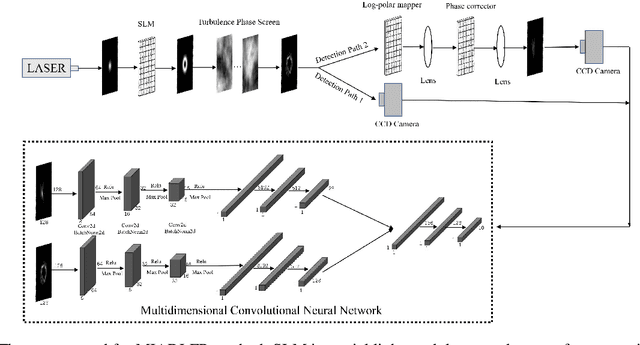
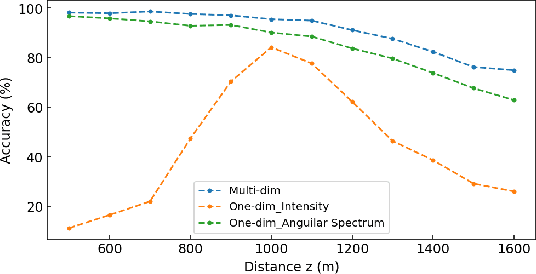
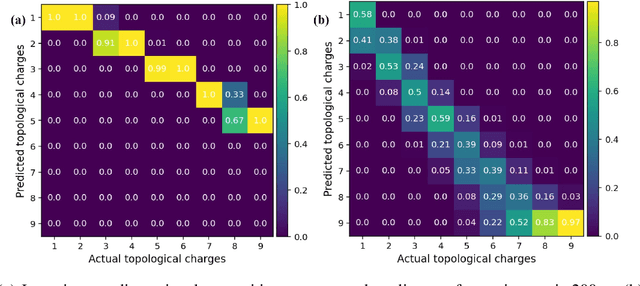
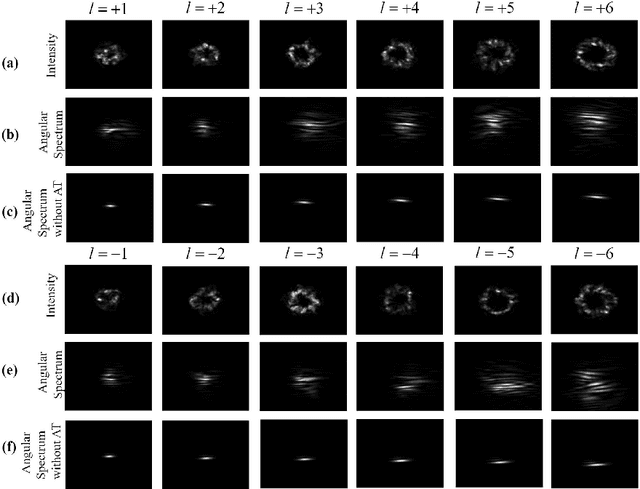
Abstract:Because of the unlimited range of state space, orbital angular momentum (OAM) as a new degree of freedom of light has attracted great attention in optical communication field. Recently there are a number of researches applying deep learning on recognition of OAM modes through atmospheric turbulence. However, there are several limitations in previous deep learning recognition methods. They all require a constant distance between the laser and receiver, which makes them clumsy and not practical. As far as we know, previous deep learning methods cannot sort vortex beams with positive and negative topological charges, which can reduce information capacity. A Multidimensional Information Assisted Deep Learning Flexible Recognition (MIADLFR) method is proposed in this letter. In MIADLR we utilize not only the intensity profile, also spectrum information to recognize OAM modes unlimited by distance and sign of topological charge (TC). As far as we know, we first make use of multidimensional information to recognize OAM modes and we first utilize spectrum information to recognize OAM modes. Recognition of OAM modes unlimited by distance and sign of TC achieved by MIADLFR method can make optical communication and detection by OAM light much more attractive.
 Add to Chrome
Add to Chrome Add to Firefox
Add to Firefox Add to Edge
Add to Edge